You may have heard that you need to “brand yourself” in order to be successful in your career. While “branding” (which is defined as “to make an indelible mark or impression on somebody or something”) is a valuable strategy, you may be more comfortable with the idea of simply positioning yourself to be successful in your job search and career.
Many jobseekers don’t realize they have already positioned themselves — they just haven’t articulated it yet. Maybe you’re known as “the sales manager that makes quota, no matter what’s going on in the economy,” or “the engineer that can speak in language the customer understands.” That’s your positioning.
To cultivate the positioning that will help you reach your career goals, you must understand and be able to communicate what makes you exceptional and compelling.
You must find a way to stand out in a crowded job search. If you’re not known for something, you won’t be known for anything. One size does not fit all.
Finding a job is a lot like dating — it’s about finding a match between two parties (you and the company). It’s not just about money — although that is important. It’s also about helping the company meet a need that it has.
Companies hire because of their needs. This is true for all jobs — from an entry-level administrative position to the CEO’s job.
Understand the emotional motivation behind the job opening. What problem is the company trying to solve? Solving the problem can be about saving time, or building customer relationships. Positioning yourself to solve a problem.
The question you want to answer for the employer is, “Why should you hire me?” When employers are hiring, they really want to know: “Why should I choose you instead of someone else?” Positioning is an important part of answering this question. You can’t be all things to all employers, so you need to figure out what sets you apart.
Personal positioning is unique to you. Figure out what makes you different. Consistency in this messaging will help you throughout the job search and interview process.
You need to express: “I am this.” Someone who is reading your résumé or LinkedIn profile should be able to recognize you in it.
The most difficult part about positioning is sounding original. Be specific about what distinguishes you. Your positioning is not your job title. Also, if your position could be said about almost anyone with your same job title, it needs work.
It’s important for a jobseeker to stand out from the pool of applicants in order to receive serious consideration as a candidate. Personal positioning allows you to establish a clear message of who you are, the experience you have, and how you can be an asset to the employer.
Make sure your personal positioning aligns with your target company’s wants, needs, and/or values. Remember: Employers hire for their reasons, not yours!
You have to get the reader’s attention quickly. Your positioning is often the first impression an employer has of you, so make it count! (And speaking of first impressions, remember that how you dress is also part of your personal positioning.)
Benefits of Positioning
The ability to communicate “why you” is important in the job search. It can help you stand out from other job candidates. It can make you memorable. You want the interviewer to say, “Oh, I remember (him/her)!”
You will also use your positioning in many ways throughout your job search. Your LinkedIn Headline can be your personal position tagline. Your tagline can also be used on your résumé and as your tagline on your Twitter account. It can also be used as the subject line in an email to a prospective employer, hiring manager, or recruiter.
Your full positioning statement can be included in your LinkedIn Summary section, worked into the Qualifications Statement or Summary on the résumé, or incorporated in your cover letter. When networking, your positioning statement can be the answer to the question, “What do you do?” In an interview, your personal position can be used when asked, “Tell me about yourself.”
Knowing your skills and professional qualifications — and being able to articulate them — will also help you navigate applicant tracking systems (ATS).
Position yourself effectively to attract connections, opportunities, and job offers.
How to Develop Your Positioning
To identify how to position yourself, it helps to examine a couple of key issues:
- What is the Company’s Need? What specific problem are they trying to solve with this job? Are they trying to make money? Save money? Save time? Keep existing customers? Acquire new customers?
- What are your Core Abilities? What special abilities do you possess that separate you from other candidates for this position?
- What are your Values? What is your belief system (behavior and ethics) that is inherent to you? Does this set you apart?
- What is your Connection to the Company’s Need? Do you possess something special that solves your target employer’s problem?
Be aware of the kind of work you are willing to do, and the kind of work you don’t want to do. Make a list of the things you like to do, and what you don’t like to do.
Look to your work history for clues to your positioning. What in your work history did you do to make things better? Look for instances where you showed leadership and accomplishments.
Check out your existing online profile. What comes up when you Google yourself? What is your social media presence? What are you known for online?
Begin with the end in mind: What job do you want? Then figure out what qualities, attributes, and skills are required for success in that job. Do you possess them? How can you demonstrate that?
Questions you should ask yourself:
- Why do I want this job?
- What can I offer?
- What do I want my next employer to know about me?
- I’m the kind of person who…
- I’m the person people turn to when…
- What are my top achievements in my career?
- What can I do that others with the same job title can’t do? What makes me different from other employees with my job title?
- What part of my job makes me want to get out of bed in the morning and go to work?
- How have I improved my work environment?
- What part of my job do I like best?
- Why am I good at what I do?
- Am I willing to go beyond what’s in my job description? What examples of this do I have?
- What role do I play in helping my co-workers and/or customers achieve the results they are seeking?
- What kinds of customers do I most enjoy working with?
- What training do I have that qualifies me to specialize in this field?
- What life experiences have I had that would be valuable to others?
- Is there an area where I’m better at something than others? How am I more productive and innovative than other candidates for this job?
- Is there a specific result I can deliver in this job?
- How does my work contribute to an employer’s bottom line?
Additional resources to help you identify what makes you stand out:
- Performance evaluations
- Customer appreciation letters
- Look through your emails to see what great things people have said about you and your work
- LinkedIn Recommendations
- Letters of commendation from colleagues and supervisors
- Ask people you know (and people you work with) for feedback. How do others see you?
Research Your Profession to Identify Your Positioning
Researching your desired job can also help you identify your unique positioning. Looking at job postings can help, but you should also consider going further in-depth. These sites can help:
O*NET Online (http://www.onetonline.org/)
This website was created for the U.S. Department of Labor/Employment and Training Administration by the National Center for O*NET Development. The O*NET program is “the nation’s primary source of occupational information,” according to the site. It contains information on hundreds of occupations and is available to jobseekers at no cost.
Every occupation requires unique knowledge, skills, and abilities. These occupational characteristics are outlined on the site. The occupational descriptions, which include descriptions of day-to-day work, along with qualifications and interests of the typical worker, allow jobseekers to identify unique positioning opportunities for themselves in their job search.
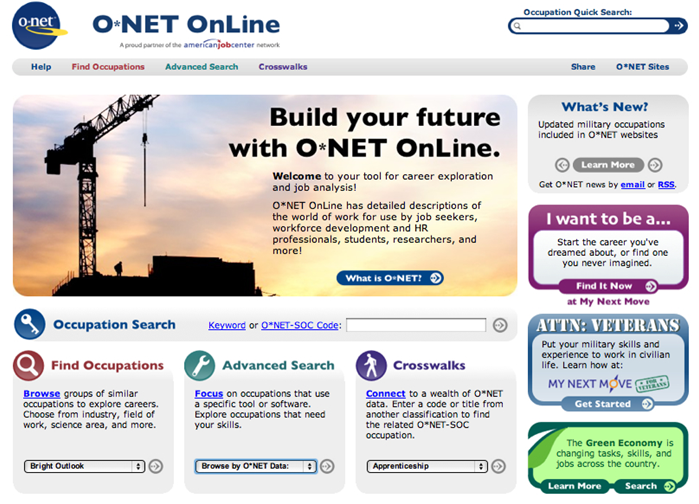
You can also access the O*NET® Interest Profiler, a free tool (available for immediate download) to assess your occupational interests. The tool offers personalized career suggestions based on your interests and level of work experience.
Access the tool here: http://www.onetcenter.org/IP.html
My Next Move (http://www.mynextmove.org/)
You can start your research on an O*NET affiliated site, My Next Move. The site is an interactive tool for jobseekers to learn more about career options. It includes descriptions, skills, and salary information for more than 900 professions. You can identify careers through keyword search, by browsing industry classification, or through the O*NET Interest Profiler.
My Next Move is maintained by the National Center for O*NET Development under the sponsorship of the U.S. Department of Labor/Employment and Training Administration.
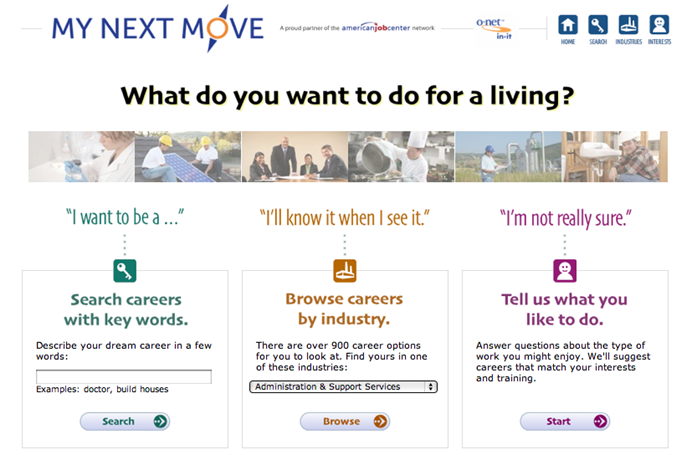
When you identify a profession, you can assess the knowledge, skills, and abilities required for success in the role. These can often provide guidance for positioning yourself. The “Personality” and “Technology” sections also give insight into your personal positioning.
The “On the Job, You Would” information includes common job functions. Look to see if these are areas where you excel — this can be a point of differentiation.
Also check out the “Also Called” information under the occupation for related job titles you can use in your personal positioning tagline.
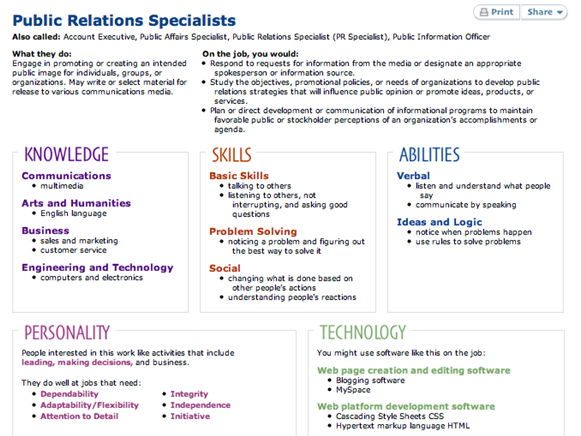
America’s Career InfoNet (http://www.careerinfonet.org/)
This website is affiliated with the U.S. Department of Labor’s CareerOneStop program. The website includes occupation and industry information, salary data, career videos, education resources, self-assessment tools, and career exploration assistance.
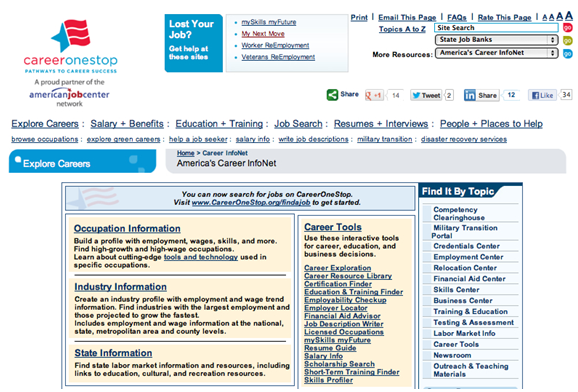
Occupational Outlook Handbook (http://www.bls.gov/ooh/)
The Occupational Outlook Handbook (OOH) provides information on what workers do, working conditions, what qualifications are required for success in the position, pay, job outlook, similar occupations, and sources of additional information for research for more than 300 occupational profiles.
To find an occupation, browse the occupational group of interest on the left-hand side of the website, or use the “A-Z Index” (if you know the specific occupation). You can also enter a job title into the “Search Handbook” box at the top of the site. You can also search for occupations by pay range, education level, training, projected number of new jobs, and projected job growth rate — using the “Occupation Finder” or occupation selector drop-down menus on the home page. If you can’t find an occupation you are interested in, look in the alphabetical index, using similar occupational titles to search for an occupation.
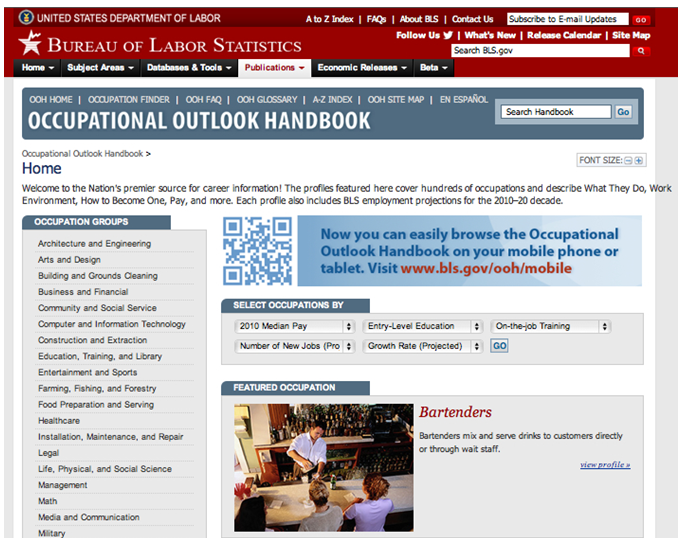
Glassdoor (http://www.glassdoor.com/)
You can also research your prospective employer to identify how to effectively position yourself to work at that specific company. Glassdoor is an excellent way to assess what is important to the employer and how you might fit in.

Creating Your Positioning
The first step is a brainstorming exercise. Make a list of possible attributes, values, and differentiators based on the exercises above and your research. Brainstorm first — don’t judge or evaluate
Then, you get to decide what your personal positioning is. Look through the words and phrases you’ve identified, and see what stands out. You may be many things, but pick one to emphasize. It may help you to ask yourself: If I were creating my ideal career, I would ____________.
If you are still having trouble identifying your positioning, use this idea from Brian Kurth, author of “Test Drive Your Dream Job.” Create a collage of your interests — quotes, photos, words, and inspiration from magazines, newspapers, and materials you find online. You can even create a Pinterest board for this. Then, mine that information to find the “theme” to your personal positioning.
Now, it’s time to actually create your positioning. Your personal position has two parts: A tagline and a full positioning statement. Your personal positioning should be authentic, relevant, compelling, and differentiate you from others.
The full positioning statement has an immediately clear focus supported by 3-5 main points that further emphasize that focus. This positioning statement will be used throughout your résumé, LinkedIn profile, and the interviewing process.
When developing your positioning statement, consider these five areas:
- Who is your target employer? (industry, size of company, public/private/non-profit)
- What problem or issue are they hiring to solve?
- What results can the employer expect by hiring you? In other words, what solution do you provide?
- What proof do you have that you can deliver results?
- What sets you apart from other candidates? What makes you different or memorable?
Your personal positioning tagline is one sentence – ideally, 5-10 words in length. It should be easily understandable and easy to remember.
This formula can be used to create your tagline:
Job Title -> Differentiator
This may be expressed without pronouns. For example:
Big Four Accountant With Operations Experience in Fortune 500 Companies
Security Guard with Anti-Terrorist Training and Ability to Identify Hidden Patterns
Hazmat Manager with Mechanical Engineering Degree From University of Virginia
Your full positioning statement is that tagline, but backed up by qualifications, accomplishments, and/or evidence. The full statement might be a single sentence, or it might be 3-5 sentences in length. Offer supporting details to backup your accomplishment claims.
Both should be clear and concise and written in present tense. They should highlight your expertise and unique abilities. You can “name drop” by including well-known companies, schools, and credentials in your positioning.
Here is a sample formula for your personal positioning statement:
Job Title -> Target Audience/What You Do -> Industry/Field -> Achievements/Results
This is expressed as:
I am a (Job Title/Profession) who (Works With Target Audience OR Who Does X/Y/Z) in the (Industry/Field) to (Highlight Accomplishments or Results).
For example:
I am a public relations specialist who provides media relations and race promotion services to the cycling community to help races attract more participants, media attention, and sponsor support.
Be sure to include:
- A target audience — who are the clients or customers you work with?
- Your employer/industry — where do you want to work? Who do you want to work for? You can even include your desired employer’s name.
- A point of difference — what sets you apart? What is the most compelling reason to choose you as a candidate? (This can be included in the “Achievements/Results” section of the personal positioning statement.)
But don’t try to stuff too much information into the statement. The positioning statement is “overstuffed” if you have more than one conjunction per sentence, or more than two punctuation marks (commas or semicolons).
Also, don’t confuse big words with effective positioning. Choose your words carefully. When possible, incorporate in keywords — nouns or phrases that can be picked up through online searches and are prominently used in applicant tracking systems.
Dos and Don’ts For Positioning
Here are things you should do:
- Do make sure your positioning reflects your personality.
- Do incorporate in keywords (nouns, industry-specific terminology, and skills) into your personal positioning.
- Do be authentic. Make sure your personal positioning reflects your personal values, qualifications, and attributes.
Here are some things you should not do:
- Don’t go on and on. Don’t tell your whole life story. Get to the point quickly.
- Don’t be too general. One of the biggest mistakes with your personal position is not being specific enough. The more specific you are, the more effective your personal positioning will be.
- Don’t be boring. You need to get the reader’s attention! Be interesting.
Positioning Can Make It Easier to Find a Job
Recruiters and hiring managers need help knowing what kind of position you’re focused on. It’s harder to find a job when you don’t know what kind of job you want. Conversely, it is easier to find a job if you know what kind of job you want.
There are fewer opportunities for average performers to be found in the hiring process, but there are tremendous opportunities for stars. Positioning helps you identify where you can be a star performer and then make the case (through your work and your career communication documents) to support this claim.
The next step is to align your job search with your positioning. Make sure your résumé and interview preparation supports this and makes your case.
Build Your Personal Position Before You Start Looking for a Job
Many jobseekers develop their personal positioning when they are looking for a new job. But personal positioning can help you be more effective — and visible — in your current job.
In your current job, get attention for the work you’re already doing:
- Offer to do a presentation showing your (or your group’s) accomplishments for the quarter.
- Contact your company’s communications department to see if they are interested in doing an article for the company newsletter on a recent project.
- Make sure you are keeping an “Accomplishments Journal” documenting your current career successes.
Develop your own communications plan in your current position. Increase your personal visibility by speaking, writing, and participating in social media. Once you’ve identified your personal positioning, see how you can incorporate it into your everyday work life. This will make you worth more to your current employer (remember, superstars stand out!) and make you more attractive as a job candidate when it is time for you to look for a new position.